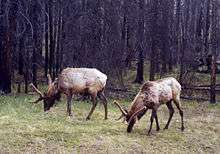Manitoban elk
The Manitoban elk (Cervus canadensis manitobensis) is a subspecies of elk found in the Midwestern United States (specifically North Dakota) and southern regions of the Canadian Prairies (specifically Manitoba, Saskatchewan, and north-central Alberta).[2][3][4] Compared to the Rocky Mountain elk, it is larger in body size, but has smaller antlers. The subspecies was driven into near extinction by 1900, but has recovered since then.
| Manitoban elk | |
|---|---|
 | |
| Scientific classification | |
| Kingdom: | Animalia |
| Phylum: | Chordata |
| Class: | Mammalia |
| Order: | Artiodactyla |
| Family: | Cervidae |
| Subfamily: | Cervinae |
| Genus: | Cervus |
| Species: | |
| Subspecies: | C. c. manitobensis |
| Trinomial name | |
| Cervus canadensis manitobensis | |
The Manitoban elk's primary predator is the wolf. Because the elk is a non-migratory species, it cannot rely on long-distance migration to reduce the risk of predation, and therefore uses a combination of behavioral patterns, such as aggregation, movement, and vigilance, to avoid predation.[5]
References
- Erxleben, J.C.P. (1777) Anfangsgründe der Naturlehre and Systema regni animalis.
- http://www.dto.com/hunting/speciesProfile/152
- http://www.wideopenspaces.com/species-elk-north-america-can-hunt/
- http://www.gothunts.com/species-of-elk/
- Vander Wal, Eric; Paquet, Paul C.; Andrés, José A. (March 2012). "Influence of landscape and social interactions on transmission of disease in a social cervid". Molecular Ecology. 21 (5): 1271–1282. doi:10.1111/j.1365-294X.2011.05431.x. ISSN 1365-294X. PMID 22289112.
This article is issued from Wikipedia. The text is licensed under Creative Commons - Attribution - Sharealike. Additional terms may apply for the media files.